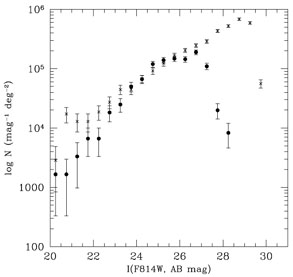


4.4. Resolved Objects
We used the image analysis package SExtractor
(Bertin & Arnouts 1996)
for object identification and photometry. The requirement for
detecting an object in our data is a core surface brightness,
µcore, of at least
2 sky within
the core 4 pixels. The isophotal detection threshold,
µiso was defined as
1.5
sky within
the core 4 pixels. The isophotal detection threshold,
µiso was defined as
1.5 sky over 6
pixels, after smoothing with a
3 × 3 boxcar filter. This corresponds to isophotal detection
thresholds of 24.7, 25.8, and 25.3 ST mag arcsec-2, at F300W,
F555W, and F814W, respectively. The shape of the smoothing kernel and
the detection threshold have little affect on detection of objects
with V555 < 27.5 A B mag, and photometry is not
strongly affected for objects with
V555 < 27 A B mag. Total magnitudes are defined
as the flux within an area at least three times larger than the
ellipse defined by the first moment radius (see
Kron 1980)
and isophotal elongation. For well-detected sources, the detection and
photometry parameters we employ are similar to those used by the HDF
team in producing the HDF catalogs (see the photometry discussion in
Williams et al. 1996).
Isophotal detection limits are roughly 1.5 mag
brighter than the HDF, in keeping with the difference in exposure
time, which is a factor of 15 - 21 in the various
bandpasses. Differential number counts for our field are plotted in
Figure 8. Our detection limits are illustrated
by the turn-over in the counts in each band. The
sky over 6
pixels, after smoothing with a
3 × 3 boxcar filter. This corresponds to isophotal detection
thresholds of 24.7, 25.8, and 25.3 ST mag arcsec-2, at F300W,
F555W, and F814W, respectively. The shape of the smoothing kernel and
the detection threshold have little affect on detection of objects
with V555 < 27.5 A B mag, and photometry is not
strongly affected for objects with
V555 < 27 A B mag. Total magnitudes are defined
as the flux within an area at least three times larger than the
ellipse defined by the first moment radius (see
Kron 1980)
and isophotal elongation. For well-detected sources, the detection and
photometry parameters we employ are similar to those used by the HDF
team in producing the HDF catalogs (see the photometry discussion in
Williams et al. 1996).
Isophotal detection limits are roughly 1.5 mag
brighter than the HDF, in keeping with the difference in exposure
time, which is a factor of 15 - 21 in the various
bandpasses. Differential number counts for our field are plotted in
Figure 8. Our detection limits are illustrated
by the turn-over in the counts in each band. The
 N-error
bars show that V ~ 23 A B mag is reasonable bright-magnitude
cut-off for observations in a field of this size. The galaxy counts
from the HDF are also plotted in Figure 8 to
demonstrate that the field we have observed contains a typical
field-galaxy population in both color and number density. The HDF is
a convenient benchmark for this comparison simply because the data are
publicly available, widely studied, and of a similarly "blank"
field. The HDF counts show twice as many galaxies at magnitudes
brighter than 23 A B mag in each of the three band, while the
difference in number density fainter than 23 A B mag is modest. Such
differences at bright magnitudes are well within the typical
field-to-field fluctuations for galaxy counts and illustrate the
need for a bright magnitude cut-off.
N-error
bars show that V ~ 23 A B mag is reasonable bright-magnitude
cut-off for observations in a field of this size. The galaxy counts
from the HDF are also plotted in Figure 8 to
demonstrate that the field we have observed contains a typical
field-galaxy population in both color and number density. The HDF is
a convenient benchmark for this comparison simply because the data are
publicly available, widely studied, and of a similarly "blank"
field. The HDF counts show twice as many galaxies at magnitudes
brighter than 23 A B mag in each of the three band, while the
difference in number density fainter than 23 A B mag is modest. Such
differences at bright magnitudes are well within the typical
field-to-field fluctuations for galaxy counts and illustrate the
need for a bright magnitude cut-off.

|

|

|
Figure 8. Differential galaxy counts with
|
Four stars are detected in the WF chips, three in WF2 with V555 = 19.0, 20.5 and 20.8 A B mag, respectively, and one in WF4 with V555 = 22.0 A B mag. Star-galaxy separation poses no difficulty; stars brighter than V555 ~ 23.0 A B mag are masked out, regardless, and the flux from stars beyond that limit is < 10% of that from detected galaxies at the same apparent magnitudes (Infante 1997).